T3 2019 1 Business Law 1/29/2020 Student's Name Contents Part A 2 Issue 2 Rules 2 References 4 Part B 5 Issue (1) 5 Rules (1) 5 Application (1) 5 Conclusion (1) 5 Issue (1) 5 Rules (2) 6 Application (
VerifiedAdded on 2022/08/19
|9
|2542
|161
AI Summary
Questions are attached as well. I need PowerPoint Slides for presentation as well. and, no plagiarism with a credit score.
Contribute Materials
Your contribution can guide someone’s learning journey. Share your
documents today.

Business Law
1/29/2020
Student’s Name
1/29/2020
Student’s Name
Secure Best Marks with AI Grader
Need help grading? Try our AI Grader for instant feedback on your assignments.
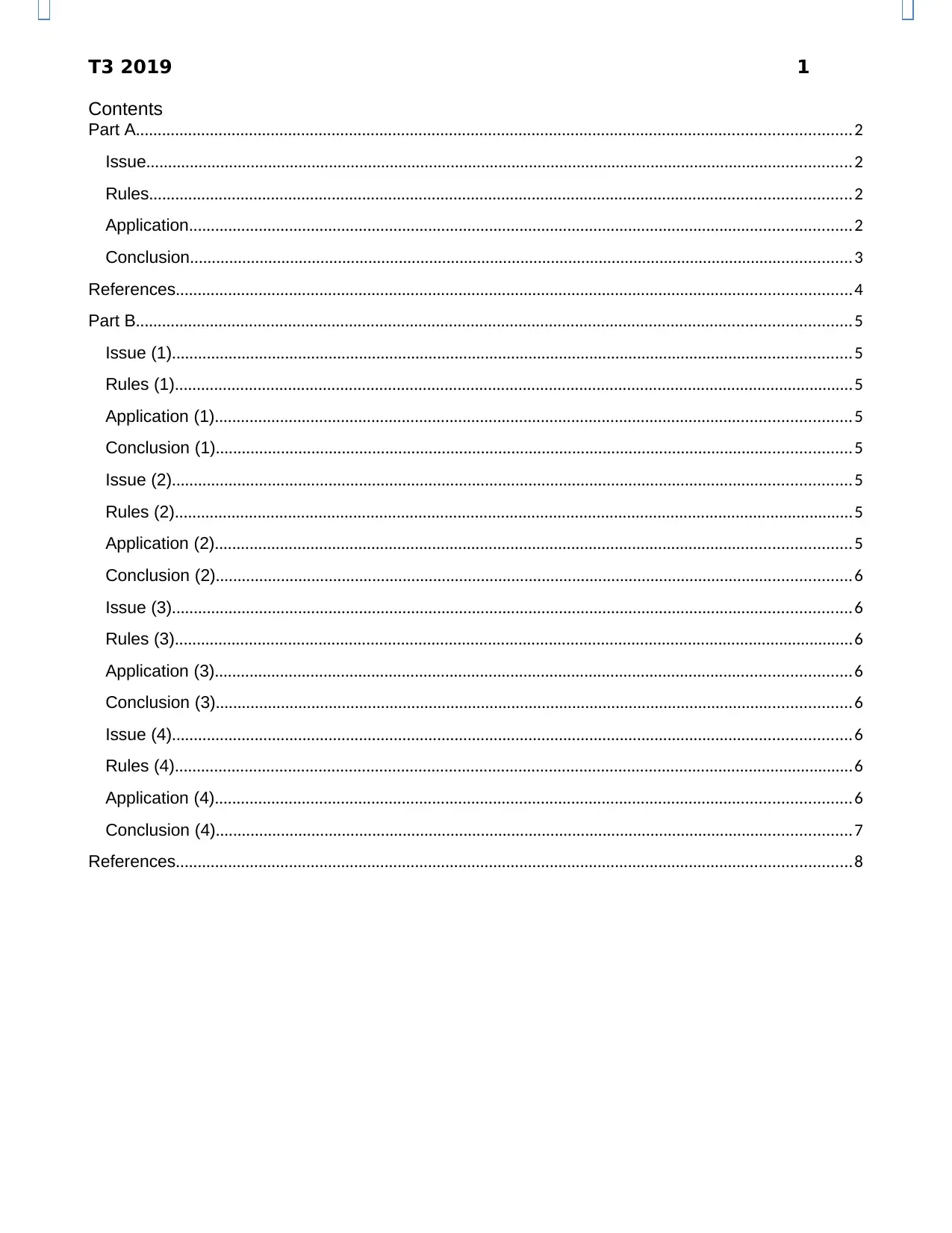
T3 2019 1
Contents
Part A....................................................................................................................................................................2
Issue..................................................................................................................................................................2
Rules.................................................................................................................................................................2
Application........................................................................................................................................................2
Conclusion........................................................................................................................................................3
References...........................................................................................................................................................4
Part B....................................................................................................................................................................5
Issue (1)............................................................................................................................................................5
Rules (1)............................................................................................................................................................5
Application (1)..................................................................................................................................................5
Conclusion (1)..................................................................................................................................................5
Issue (2)............................................................................................................................................................5
Rules (2)............................................................................................................................................................5
Application (2)..................................................................................................................................................5
Conclusion (2)..................................................................................................................................................6
Issue (3)............................................................................................................................................................6
Rules (3)............................................................................................................................................................6
Application (3)..................................................................................................................................................6
Conclusion (3)..................................................................................................................................................6
Issue (4)............................................................................................................................................................6
Rules (4)............................................................................................................................................................6
Application (4)..................................................................................................................................................6
Conclusion (4)..................................................................................................................................................7
References...........................................................................................................................................................8
Contents
Part A....................................................................................................................................................................2
Issue..................................................................................................................................................................2
Rules.................................................................................................................................................................2
Application........................................................................................................................................................2
Conclusion........................................................................................................................................................3
References...........................................................................................................................................................4
Part B....................................................................................................................................................................5
Issue (1)............................................................................................................................................................5
Rules (1)............................................................................................................................................................5
Application (1)..................................................................................................................................................5
Conclusion (1)..................................................................................................................................................5
Issue (2)............................................................................................................................................................5
Rules (2)............................................................................................................................................................5
Application (2)..................................................................................................................................................5
Conclusion (2)..................................................................................................................................................6
Issue (3)............................................................................................................................................................6
Rules (3)............................................................................................................................................................6
Application (3)..................................................................................................................................................6
Conclusion (3)..................................................................................................................................................6
Issue (4)............................................................................................................................................................6
Rules (4)............................................................................................................................................................6
Application (4)..................................................................................................................................................6
Conclusion (4)..................................................................................................................................................7
References...........................................................................................................................................................8
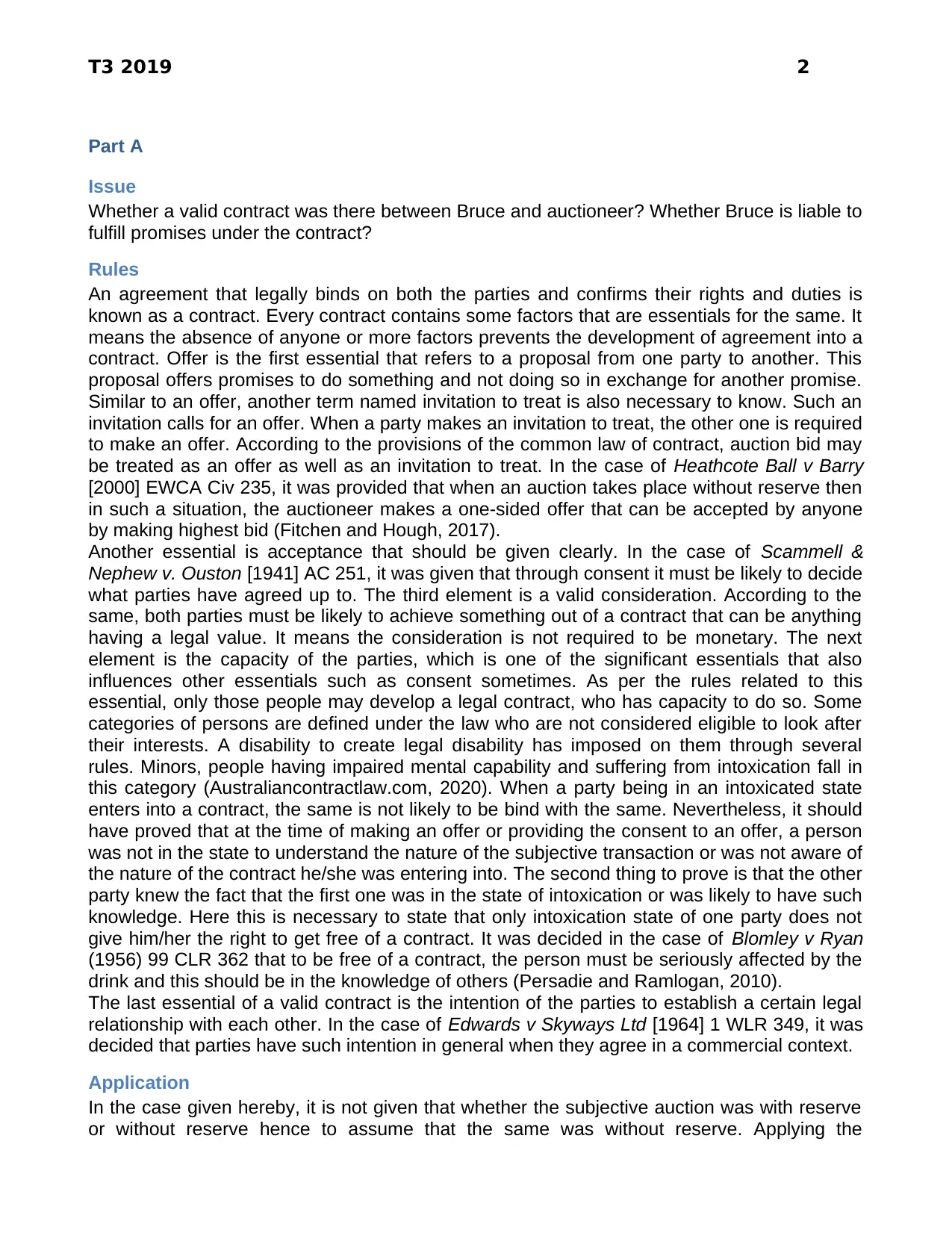
T3 2019 2
Part A
Issue
Whether a valid contract was there between Bruce and auctioneer? Whether Bruce is liable to
fulfill promises under the contract?
Rules
An agreement that legally binds on both the parties and confirms their rights and duties is
known as a contract. Every contract contains some factors that are essentials for the same. It
means the absence of anyone or more factors prevents the development of agreement into a
contract. Offer is the first essential that refers to a proposal from one party to another. This
proposal offers promises to do something and not doing so in exchange for another promise.
Similar to an offer, another term named invitation to treat is also necessary to know. Such an
invitation calls for an offer. When a party makes an invitation to treat, the other one is required
to make an offer. According to the provisions of the common law of contract, auction bid may
be treated as an offer as well as an invitation to treat. In the case of Heathcote Ball v Barry
[2000] EWCA Civ 235, it was provided that when an auction takes place without reserve then
in such a situation, the auctioneer makes a one-sided offer that can be accepted by anyone
by making highest bid (Fitchen and Hough, 2017).
Another essential is acceptance that should be given clearly. In the case of Scammell &
Nephew v. Ouston [1941] AC 251, it was given that through consent it must be likely to decide
what parties have agreed up to. The third element is a valid consideration. According to the
same, both parties must be likely to achieve something out of a contract that can be anything
having a legal value. It means the consideration is not required to be monetary. The next
element is the capacity of the parties, which is one of the significant essentials that also
influences other essentials such as consent sometimes. As per the rules related to this
essential, only those people may develop a legal contract, who has capacity to do so. Some
categories of persons are defined under the law who are not considered eligible to look after
their interests. A disability to create legal disability has imposed on them through several
rules. Minors, people having impaired mental capability and suffering from intoxication fall in
this category (Australiancontractlaw.com, 2020). When a party being in an intoxicated state
enters into a contract, the same is not likely to be bind with the same. Nevertheless, it should
have proved that at the time of making an offer or providing the consent to an offer, a person
was not in the state to understand the nature of the subjective transaction or was not aware of
the nature of the contract he/she was entering into. The second thing to prove is that the other
party knew the fact that the first one was in the state of intoxication or was likely to have such
knowledge. Here this is necessary to state that only intoxication state of one party does not
give him/her the right to get free of a contract. It was decided in the case of Blomley v Ryan
(1956) 99 CLR 362 that to be free of a contract, the person must be seriously affected by the
drink and this should be in the knowledge of others (Persadie and Ramlogan, 2010).
The last essential of a valid contract is the intention of the parties to establish a certain legal
relationship with each other. In the case of Edwards v Skyways Ltd [1964] 1 WLR 349, it was
decided that parties have such intention in general when they agree in a commercial context.
Application
In the case given hereby, it is not given that whether the subjective auction was with reserve
or without reserve hence to assume that the same was without reserve. Applying the
Part A
Issue
Whether a valid contract was there between Bruce and auctioneer? Whether Bruce is liable to
fulfill promises under the contract?
Rules
An agreement that legally binds on both the parties and confirms their rights and duties is
known as a contract. Every contract contains some factors that are essentials for the same. It
means the absence of anyone or more factors prevents the development of agreement into a
contract. Offer is the first essential that refers to a proposal from one party to another. This
proposal offers promises to do something and not doing so in exchange for another promise.
Similar to an offer, another term named invitation to treat is also necessary to know. Such an
invitation calls for an offer. When a party makes an invitation to treat, the other one is required
to make an offer. According to the provisions of the common law of contract, auction bid may
be treated as an offer as well as an invitation to treat. In the case of Heathcote Ball v Barry
[2000] EWCA Civ 235, it was provided that when an auction takes place without reserve then
in such a situation, the auctioneer makes a one-sided offer that can be accepted by anyone
by making highest bid (Fitchen and Hough, 2017).
Another essential is acceptance that should be given clearly. In the case of Scammell &
Nephew v. Ouston [1941] AC 251, it was given that through consent it must be likely to decide
what parties have agreed up to. The third element is a valid consideration. According to the
same, both parties must be likely to achieve something out of a contract that can be anything
having a legal value. It means the consideration is not required to be monetary. The next
element is the capacity of the parties, which is one of the significant essentials that also
influences other essentials such as consent sometimes. As per the rules related to this
essential, only those people may develop a legal contract, who has capacity to do so. Some
categories of persons are defined under the law who are not considered eligible to look after
their interests. A disability to create legal disability has imposed on them through several
rules. Minors, people having impaired mental capability and suffering from intoxication fall in
this category (Australiancontractlaw.com, 2020). When a party being in an intoxicated state
enters into a contract, the same is not likely to be bind with the same. Nevertheless, it should
have proved that at the time of making an offer or providing the consent to an offer, a person
was not in the state to understand the nature of the subjective transaction or was not aware of
the nature of the contract he/she was entering into. The second thing to prove is that the other
party knew the fact that the first one was in the state of intoxication or was likely to have such
knowledge. Here this is necessary to state that only intoxication state of one party does not
give him/her the right to get free of a contract. It was decided in the case of Blomley v Ryan
(1956) 99 CLR 362 that to be free of a contract, the person must be seriously affected by the
drink and this should be in the knowledge of others (Persadie and Ramlogan, 2010).
The last essential of a valid contract is the intention of the parties to establish a certain legal
relationship with each other. In the case of Edwards v Skyways Ltd [1964] 1 WLR 349, it was
decided that parties have such intention in general when they agree in a commercial context.
Application
In the case given hereby, it is not given that whether the subjective auction was with reserve
or without reserve hence to assume that the same was without reserve. Applying the
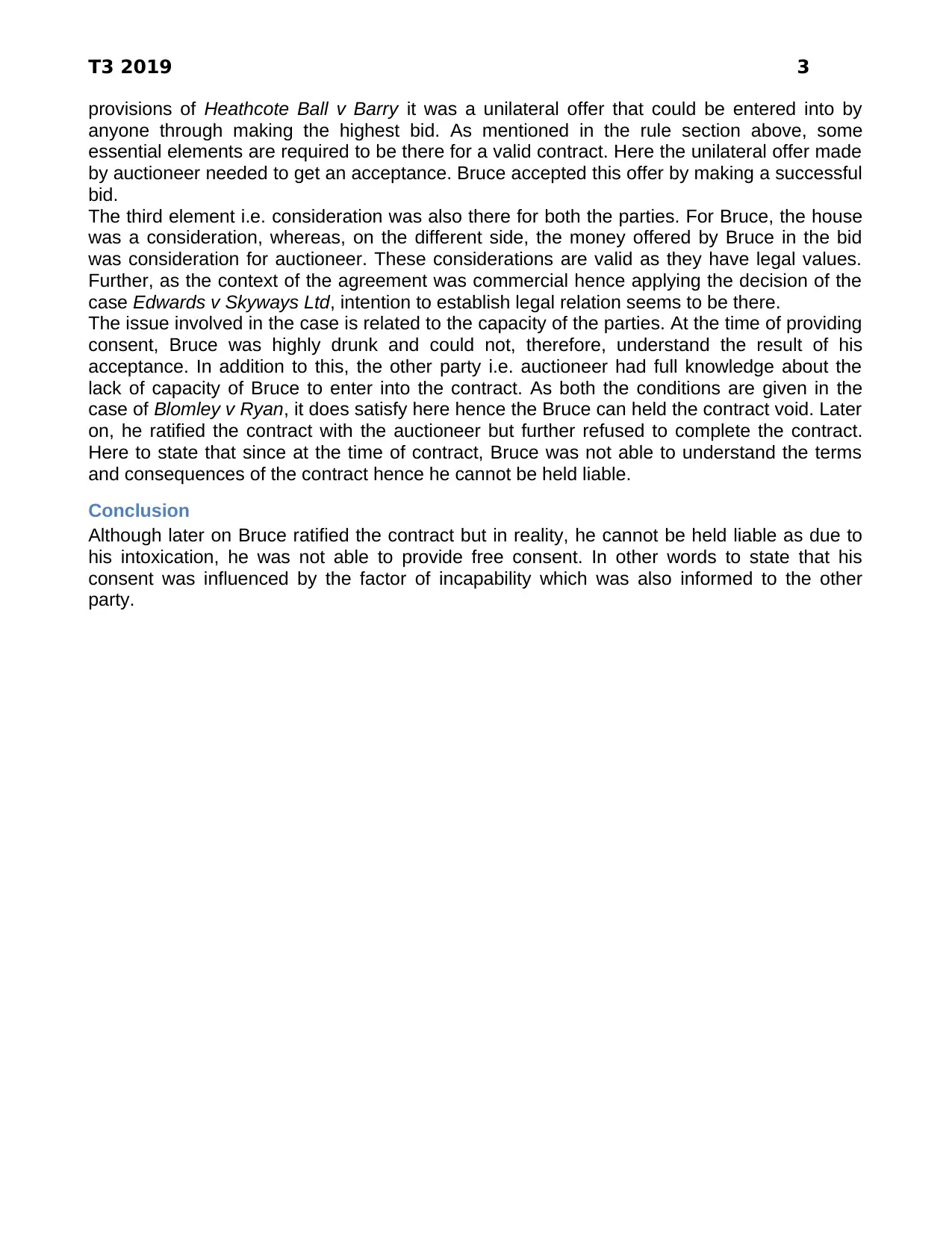
T3 2019 3
provisions of Heathcote Ball v Barry it was a unilateral offer that could be entered into by
anyone through making the highest bid. As mentioned in the rule section above, some
essential elements are required to be there for a valid contract. Here the unilateral offer made
by auctioneer needed to get an acceptance. Bruce accepted this offer by making a successful
bid.
The third element i.e. consideration was also there for both the parties. For Bruce, the house
was a consideration, whereas, on the different side, the money offered by Bruce in the bid
was consideration for auctioneer. These considerations are valid as they have legal values.
Further, as the context of the agreement was commercial hence applying the decision of the
case Edwards v Skyways Ltd, intention to establish legal relation seems to be there.
The issue involved in the case is related to the capacity of the parties. At the time of providing
consent, Bruce was highly drunk and could not, therefore, understand the result of his
acceptance. In addition to this, the other party i.e. auctioneer had full knowledge about the
lack of capacity of Bruce to enter into the contract. As both the conditions are given in the
case of Blomley v Ryan, it does satisfy here hence the Bruce can held the contract void. Later
on, he ratified the contract with the auctioneer but further refused to complete the contract.
Here to state that since at the time of contract, Bruce was not able to understand the terms
and consequences of the contract hence he cannot be held liable.
Conclusion
Although later on Bruce ratified the contract but in reality, he cannot be held liable as due to
his intoxication, he was not able to provide free consent. In other words to state that his
consent was influenced by the factor of incapability which was also informed to the other
party.
provisions of Heathcote Ball v Barry it was a unilateral offer that could be entered into by
anyone through making the highest bid. As mentioned in the rule section above, some
essential elements are required to be there for a valid contract. Here the unilateral offer made
by auctioneer needed to get an acceptance. Bruce accepted this offer by making a successful
bid.
The third element i.e. consideration was also there for both the parties. For Bruce, the house
was a consideration, whereas, on the different side, the money offered by Bruce in the bid
was consideration for auctioneer. These considerations are valid as they have legal values.
Further, as the context of the agreement was commercial hence applying the decision of the
case Edwards v Skyways Ltd, intention to establish legal relation seems to be there.
The issue involved in the case is related to the capacity of the parties. At the time of providing
consent, Bruce was highly drunk and could not, therefore, understand the result of his
acceptance. In addition to this, the other party i.e. auctioneer had full knowledge about the
lack of capacity of Bruce to enter into the contract. As both the conditions are given in the
case of Blomley v Ryan, it does satisfy here hence the Bruce can held the contract void. Later
on, he ratified the contract with the auctioneer but further refused to complete the contract.
Here to state that since at the time of contract, Bruce was not able to understand the terms
and consequences of the contract hence he cannot be held liable.
Conclusion
Although later on Bruce ratified the contract but in reality, he cannot be held liable as due to
his intoxication, he was not able to provide free consent. In other words to state that his
consent was influenced by the factor of incapability which was also informed to the other
party.
Secure Best Marks with AI Grader
Need help grading? Try our AI Grader for instant feedback on your assignments.
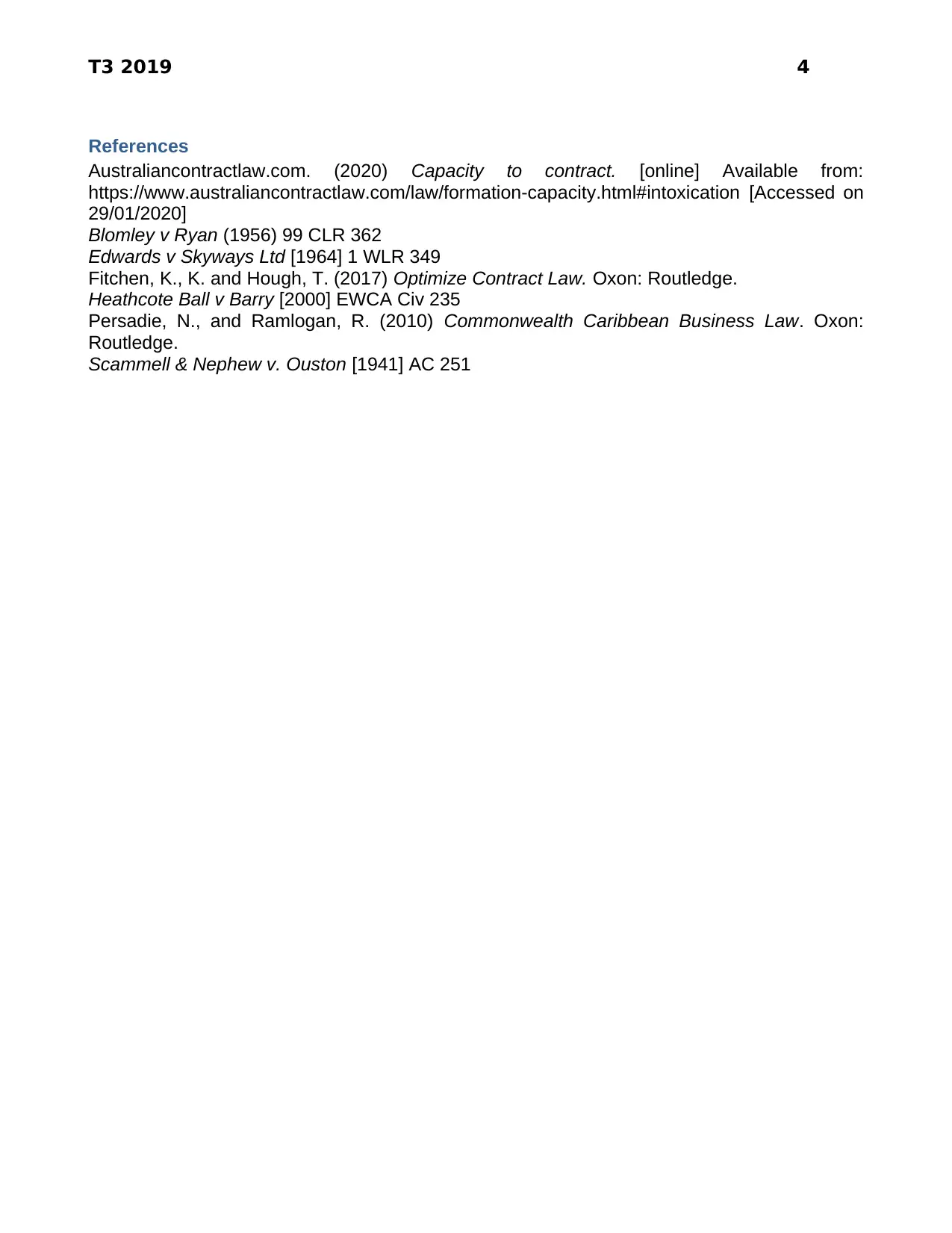
T3 2019 4
References
Australiancontractlaw.com. (2020) Capacity to contract. [online] Available from:
https://www.australiancontractlaw.com/law/formation-capacity.html#intoxication [Accessed on
29/01/2020]
Blomley v Ryan (1956) 99 CLR 362
Edwards v Skyways Ltd [1964] 1 WLR 349
Fitchen, K., K. and Hough, T. (2017) Optimize Contract Law. Oxon: Routledge.
Heathcote Ball v Barry [2000] EWCA Civ 235
Persadie, N., and Ramlogan, R. (2010) Commonwealth Caribbean Business Law. Oxon:
Routledge.
Scammell & Nephew v. Ouston [1941] AC 251
References
Australiancontractlaw.com. (2020) Capacity to contract. [online] Available from:
https://www.australiancontractlaw.com/law/formation-capacity.html#intoxication [Accessed on
29/01/2020]
Blomley v Ryan (1956) 99 CLR 362
Edwards v Skyways Ltd [1964] 1 WLR 349
Fitchen, K., K. and Hough, T. (2017) Optimize Contract Law. Oxon: Routledge.
Heathcote Ball v Barry [2000] EWCA Civ 235
Persadie, N., and Ramlogan, R. (2010) Commonwealth Caribbean Business Law. Oxon:
Routledge.
Scammell & Nephew v. Ouston [1941] AC 251
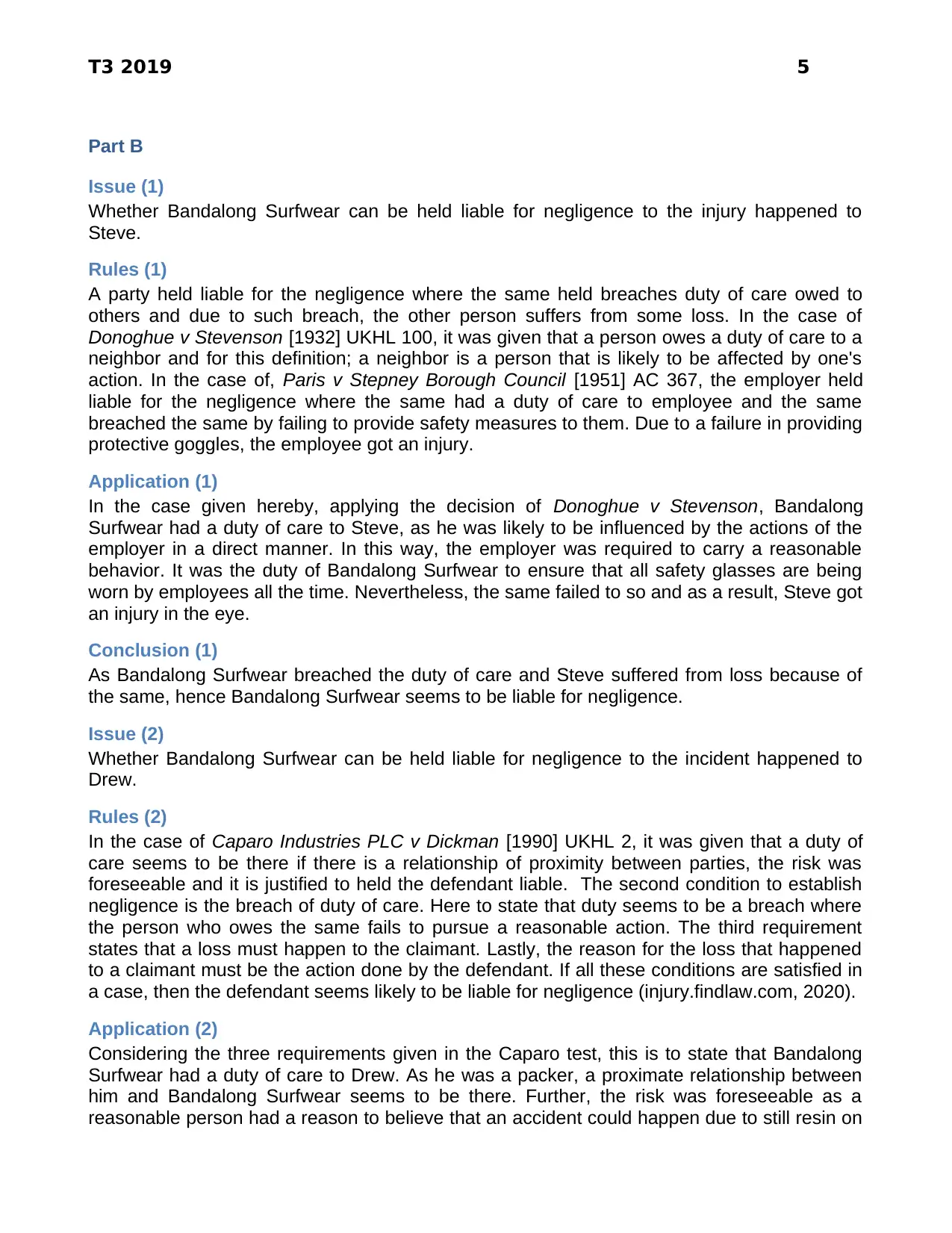
T3 2019 5
Part B
Issue (1)
Whether Bandalong Surfwear can be held liable for negligence to the injury happened to
Steve.
Rules (1)
A party held liable for the negligence where the same held breaches duty of care owed to
others and due to such breach, the other person suffers from some loss. In the case of
Donoghue v Stevenson [1932] UKHL 100, it was given that a person owes a duty of care to a
neighbor and for this definition; a neighbor is a person that is likely to be affected by one's
action. In the case of, Paris v Stepney Borough Council [1951] AC 367, the employer held
liable for the negligence where the same had a duty of care to employee and the same
breached the same by failing to provide safety measures to them. Due to a failure in providing
protective goggles, the employee got an injury.
Application (1)
In the case given hereby, applying the decision of Donoghue v Stevenson, Bandalong
Surfwear had a duty of care to Steve, as he was likely to be influenced by the actions of the
employer in a direct manner. In this way, the employer was required to carry a reasonable
behavior. It was the duty of Bandalong Surfwear to ensure that all safety glasses are being
worn by employees all the time. Nevertheless, the same failed to so and as a result, Steve got
an injury in the eye.
Conclusion (1)
As Bandalong Surfwear breached the duty of care and Steve suffered from loss because of
the same, hence Bandalong Surfwear seems to be liable for negligence.
Issue (2)
Whether Bandalong Surfwear can be held liable for negligence to the incident happened to
Drew.
Rules (2)
In the case of Caparo Industries PLC v Dickman [1990] UKHL 2, it was given that a duty of
care seems to be there if there is a relationship of proximity between parties, the risk was
foreseeable and it is justified to held the defendant liable. The second condition to establish
negligence is the breach of duty of care. Here to state that duty seems to be a breach where
the person who owes the same fails to pursue a reasonable action. The third requirement
states that a loss must happen to the claimant. Lastly, the reason for the loss that happened
to a claimant must be the action done by the defendant. If all these conditions are satisfied in
a case, then the defendant seems likely to be liable for negligence (injury.findlaw.com, 2020).
Application (2)
Considering the three requirements given in the Caparo test, this is to state that Bandalong
Surfwear had a duty of care to Drew. As he was a packer, a proximate relationship between
him and Bandalong Surfwear seems to be there. Further, the risk was foreseeable as a
reasonable person had a reason to believe that an accident could happen due to still resin on
Part B
Issue (1)
Whether Bandalong Surfwear can be held liable for negligence to the injury happened to
Steve.
Rules (1)
A party held liable for the negligence where the same held breaches duty of care owed to
others and due to such breach, the other person suffers from some loss. In the case of
Donoghue v Stevenson [1932] UKHL 100, it was given that a person owes a duty of care to a
neighbor and for this definition; a neighbor is a person that is likely to be affected by one's
action. In the case of, Paris v Stepney Borough Council [1951] AC 367, the employer held
liable for the negligence where the same had a duty of care to employee and the same
breached the same by failing to provide safety measures to them. Due to a failure in providing
protective goggles, the employee got an injury.
Application (1)
In the case given hereby, applying the decision of Donoghue v Stevenson, Bandalong
Surfwear had a duty of care to Steve, as he was likely to be influenced by the actions of the
employer in a direct manner. In this way, the employer was required to carry a reasonable
behavior. It was the duty of Bandalong Surfwear to ensure that all safety glasses are being
worn by employees all the time. Nevertheless, the same failed to so and as a result, Steve got
an injury in the eye.
Conclusion (1)
As Bandalong Surfwear breached the duty of care and Steve suffered from loss because of
the same, hence Bandalong Surfwear seems to be liable for negligence.
Issue (2)
Whether Bandalong Surfwear can be held liable for negligence to the incident happened to
Drew.
Rules (2)
In the case of Caparo Industries PLC v Dickman [1990] UKHL 2, it was given that a duty of
care seems to be there if there is a relationship of proximity between parties, the risk was
foreseeable and it is justified to held the defendant liable. The second condition to establish
negligence is the breach of duty of care. Here to state that duty seems to be a breach where
the person who owes the same fails to pursue a reasonable action. The third requirement
states that a loss must happen to the claimant. Lastly, the reason for the loss that happened
to a claimant must be the action done by the defendant. If all these conditions are satisfied in
a case, then the defendant seems likely to be liable for negligence (injury.findlaw.com, 2020).
Application (2)
Considering the three requirements given in the Caparo test, this is to state that Bandalong
Surfwear had a duty of care to Drew. As he was a packer, a proximate relationship between
him and Bandalong Surfwear seems to be there. Further, the risk was foreseeable as a
reasonable person had a reason to believe that an accident could happen due to still resin on
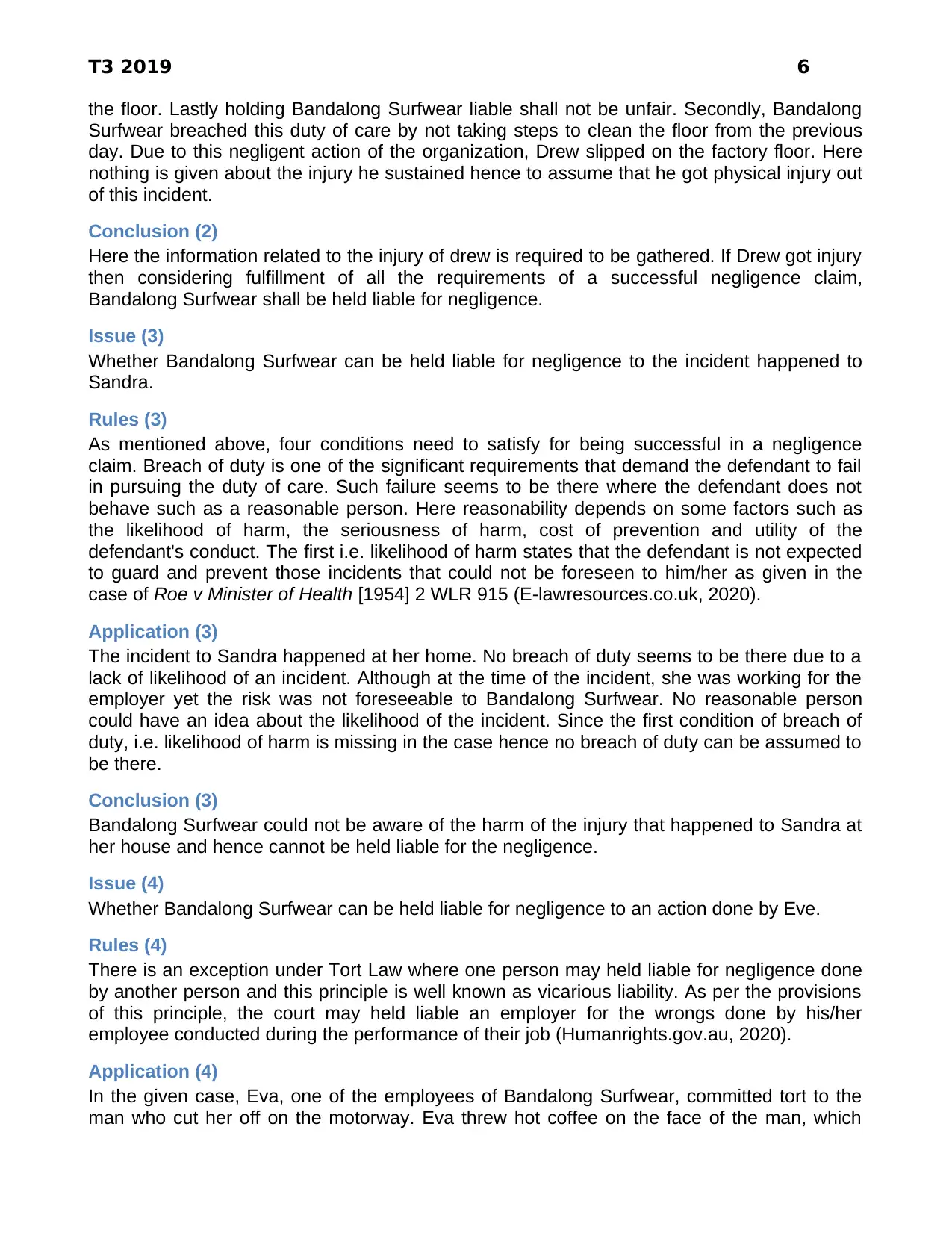
T3 2019 6
the floor. Lastly holding Bandalong Surfwear liable shall not be unfair. Secondly, Bandalong
Surfwear breached this duty of care by not taking steps to clean the floor from the previous
day. Due to this negligent action of the organization, Drew slipped on the factory floor. Here
nothing is given about the injury he sustained hence to assume that he got physical injury out
of this incident.
Conclusion (2)
Here the information related to the injury of drew is required to be gathered. If Drew got injury
then considering fulfillment of all the requirements of a successful negligence claim,
Bandalong Surfwear shall be held liable for negligence.
Issue (3)
Whether Bandalong Surfwear can be held liable for negligence to the incident happened to
Sandra.
Rules (3)
As mentioned above, four conditions need to satisfy for being successful in a negligence
claim. Breach of duty is one of the significant requirements that demand the defendant to fail
in pursuing the duty of care. Such failure seems to be there where the defendant does not
behave such as a reasonable person. Here reasonability depends on some factors such as
the likelihood of harm, the seriousness of harm, cost of prevention and utility of the
defendant's conduct. The first i.e. likelihood of harm states that the defendant is not expected
to guard and prevent those incidents that could not be foreseen to him/her as given in the
case of Roe v Minister of Health [1954] 2 WLR 915 (E-lawresources.co.uk, 2020).
Application (3)
The incident to Sandra happened at her home. No breach of duty seems to be there due to a
lack of likelihood of an incident. Although at the time of the incident, she was working for the
employer yet the risk was not foreseeable to Bandalong Surfwear. No reasonable person
could have an idea about the likelihood of the incident. Since the first condition of breach of
duty, i.e. likelihood of harm is missing in the case hence no breach of duty can be assumed to
be there.
Conclusion (3)
Bandalong Surfwear could not be aware of the harm of the injury that happened to Sandra at
her house and hence cannot be held liable for the negligence.
Issue (4)
Whether Bandalong Surfwear can be held liable for negligence to an action done by Eve.
Rules (4)
There is an exception under Tort Law where one person may held liable for negligence done
by another person and this principle is well known as vicarious liability. As per the provisions
of this principle, the court may held liable an employer for the wrongs done by his/her
employee conducted during the performance of their job (Humanrights.gov.au, 2020).
Application (4)
In the given case, Eva, one of the employees of Bandalong Surfwear, committed tort to the
man who cut her off on the motorway. Eva threw hot coffee on the face of the man, which
the floor. Lastly holding Bandalong Surfwear liable shall not be unfair. Secondly, Bandalong
Surfwear breached this duty of care by not taking steps to clean the floor from the previous
day. Due to this negligent action of the organization, Drew slipped on the factory floor. Here
nothing is given about the injury he sustained hence to assume that he got physical injury out
of this incident.
Conclusion (2)
Here the information related to the injury of drew is required to be gathered. If Drew got injury
then considering fulfillment of all the requirements of a successful negligence claim,
Bandalong Surfwear shall be held liable for negligence.
Issue (3)
Whether Bandalong Surfwear can be held liable for negligence to the incident happened to
Sandra.
Rules (3)
As mentioned above, four conditions need to satisfy for being successful in a negligence
claim. Breach of duty is one of the significant requirements that demand the defendant to fail
in pursuing the duty of care. Such failure seems to be there where the defendant does not
behave such as a reasonable person. Here reasonability depends on some factors such as
the likelihood of harm, the seriousness of harm, cost of prevention and utility of the
defendant's conduct. The first i.e. likelihood of harm states that the defendant is not expected
to guard and prevent those incidents that could not be foreseen to him/her as given in the
case of Roe v Minister of Health [1954] 2 WLR 915 (E-lawresources.co.uk, 2020).
Application (3)
The incident to Sandra happened at her home. No breach of duty seems to be there due to a
lack of likelihood of an incident. Although at the time of the incident, she was working for the
employer yet the risk was not foreseeable to Bandalong Surfwear. No reasonable person
could have an idea about the likelihood of the incident. Since the first condition of breach of
duty, i.e. likelihood of harm is missing in the case hence no breach of duty can be assumed to
be there.
Conclusion (3)
Bandalong Surfwear could not be aware of the harm of the injury that happened to Sandra at
her house and hence cannot be held liable for the negligence.
Issue (4)
Whether Bandalong Surfwear can be held liable for negligence to an action done by Eve.
Rules (4)
There is an exception under Tort Law where one person may held liable for negligence done
by another person and this principle is well known as vicarious liability. As per the provisions
of this principle, the court may held liable an employer for the wrongs done by his/her
employee conducted during the performance of their job (Humanrights.gov.au, 2020).
Application (4)
In the given case, Eva, one of the employees of Bandalong Surfwear, committed tort to the
man who cut her off on the motorway. Eva threw hot coffee on the face of the man, which
Paraphrase This Document
Need a fresh take? Get an instant paraphrase of this document with our AI Paraphraser
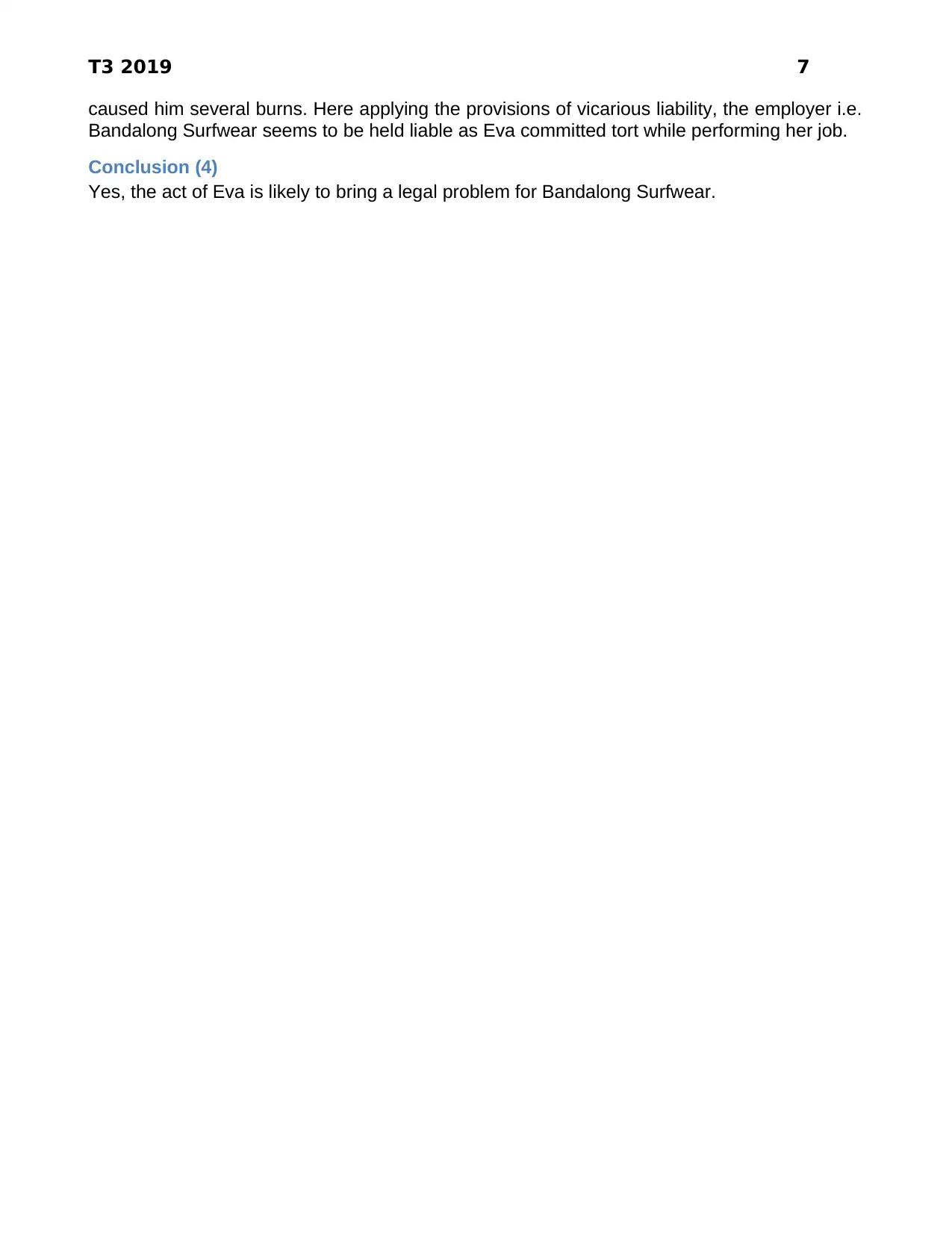
T3 2019 7
caused him several burns. Here applying the provisions of vicarious liability, the employer i.e.
Bandalong Surfwear seems to be held liable as Eva committed tort while performing her job.
Conclusion (4)
Yes, the act of Eva is likely to bring a legal problem for Bandalong Surfwear.
caused him several burns. Here applying the provisions of vicarious liability, the employer i.e.
Bandalong Surfwear seems to be held liable as Eva committed tort while performing her job.
Conclusion (4)
Yes, the act of Eva is likely to bring a legal problem for Bandalong Surfwear.
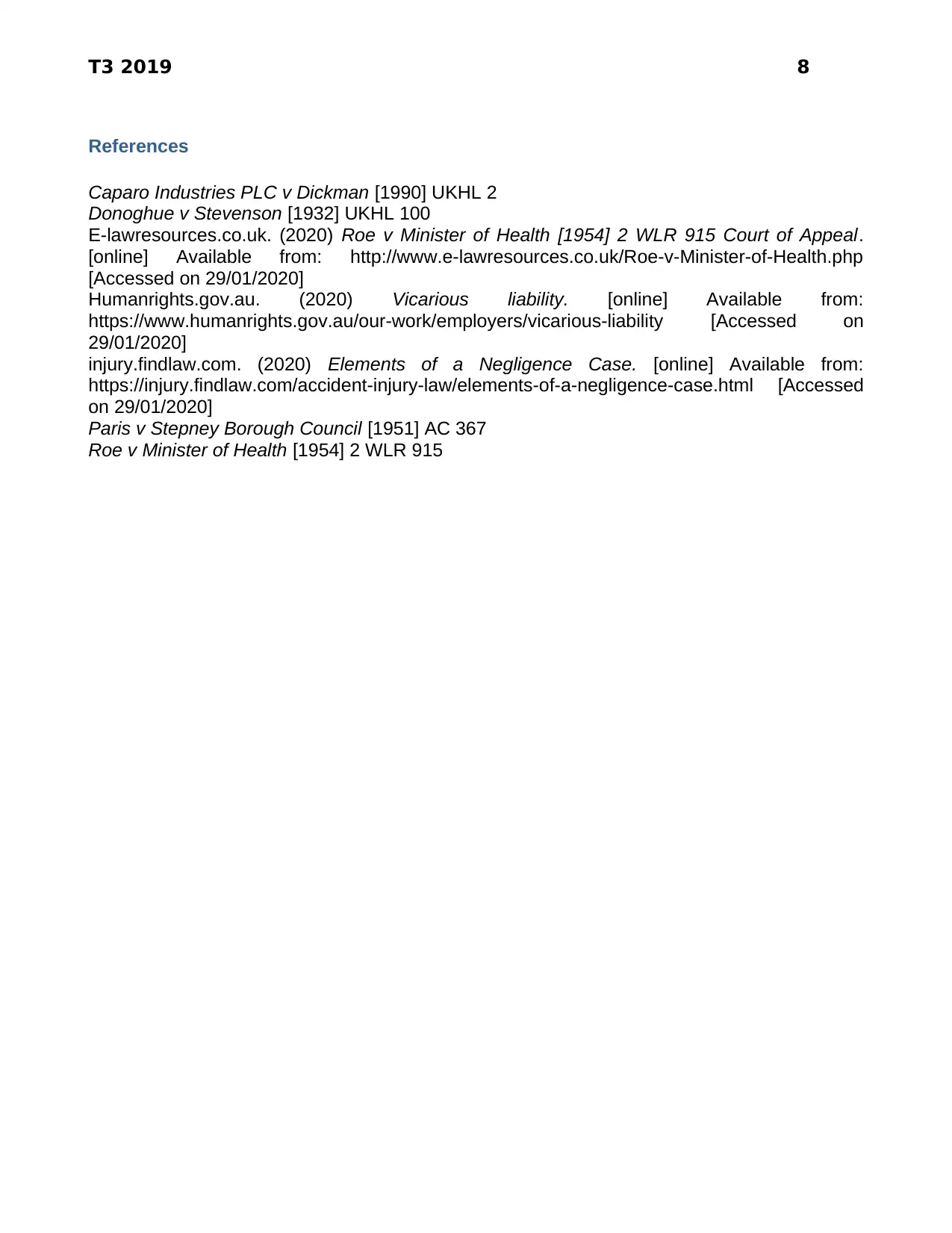
T3 2019 8
References
Caparo Industries PLC v Dickman [1990] UKHL 2
Donoghue v Stevenson [1932] UKHL 100
E-lawresources.co.uk. (2020) Roe v Minister of Health [1954] 2 WLR 915 Court of Appeal.
[online] Available from: http://www.e-lawresources.co.uk/Roe-v-Minister-of-Health.php
[Accessed on 29/01/2020]
Humanrights.gov.au. (2020) Vicarious liability. [online] Available from:
https://www.humanrights.gov.au/our-work/employers/vicarious-liability [Accessed on
29/01/2020]
injury.findlaw.com. (2020) Elements of a Negligence Case. [online] Available from:
https://injury.findlaw.com/accident-injury-law/elements-of-a-negligence-case.html [Accessed
on 29/01/2020]
Paris v Stepney Borough Council [1951] AC 367
Roe v Minister of Health [1954] 2 WLR 915
References
Caparo Industries PLC v Dickman [1990] UKHL 2
Donoghue v Stevenson [1932] UKHL 100
E-lawresources.co.uk. (2020) Roe v Minister of Health [1954] 2 WLR 915 Court of Appeal.
[online] Available from: http://www.e-lawresources.co.uk/Roe-v-Minister-of-Health.php
[Accessed on 29/01/2020]
Humanrights.gov.au. (2020) Vicarious liability. [online] Available from:
https://www.humanrights.gov.au/our-work/employers/vicarious-liability [Accessed on
29/01/2020]
injury.findlaw.com. (2020) Elements of a Negligence Case. [online] Available from:
https://injury.findlaw.com/accident-injury-law/elements-of-a-negligence-case.html [Accessed
on 29/01/2020]
Paris v Stepney Borough Council [1951] AC 367
Roe v Minister of Health [1954] 2 WLR 915
1 out of 9
Related Documents
Your All-in-One AI-Powered Toolkit for Academic Success.
+13062052269
info@desklib.com
Available 24*7 on WhatsApp / Email
![[object Object]](/_next/static/media/star-bottom.7253800d.svg)
Unlock your academic potential
© 2024 | Zucol Services PVT LTD | All rights reserved.





